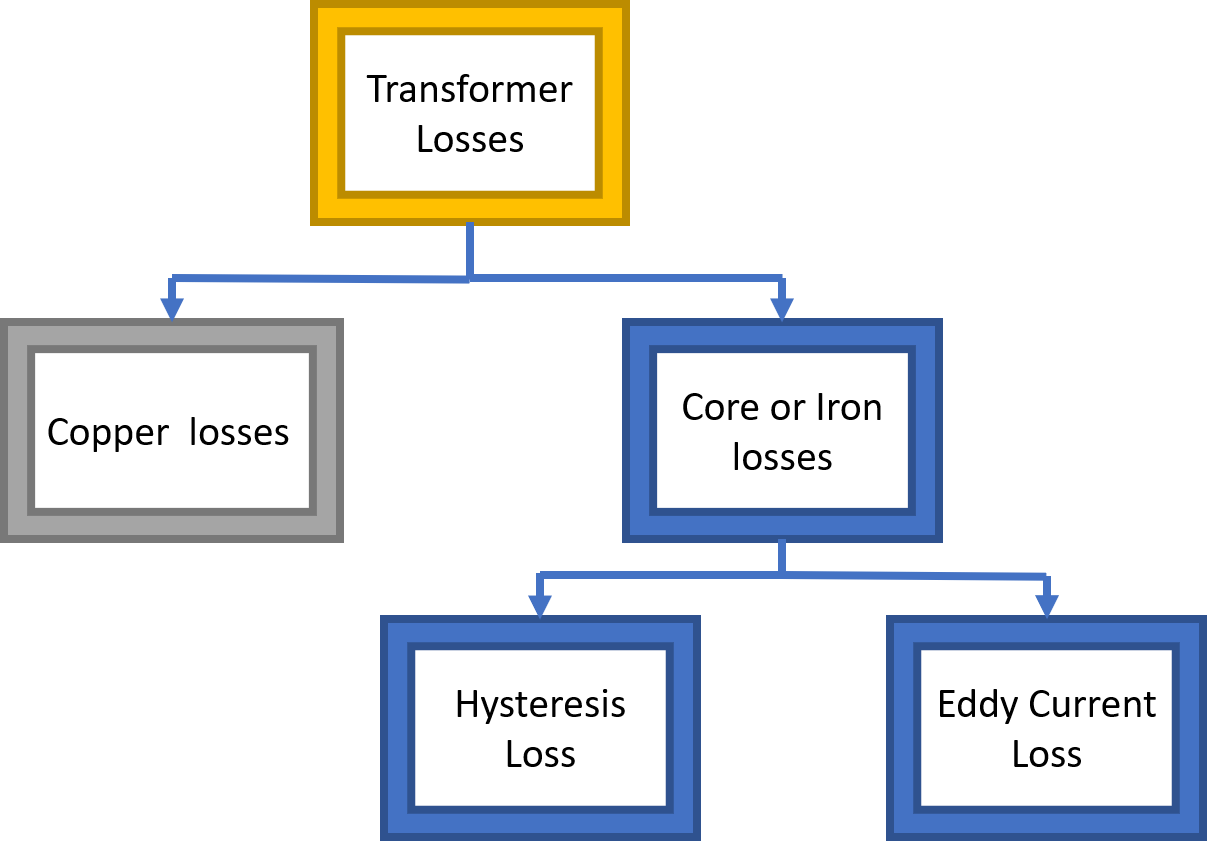In this topic, you study Transformer Losses.
When the practical transformer transfers electrical energy from one circuit to another circuit, some energy (even though small) is always lost in this process. There are two types of power losses in the transformer :
- Copper losses
- Core or Iron losses.

Copper Losses in Transformer
These losses represent the loss of power caused by the resistance of the windings (both, the primary and the secondary) due to the current flow through them. These are called copper losses since copper conductor is generally used for the windings. The power loss on this account is proportional to the square of the current flowing through the winding and is ultimately utilized in heating the windings. If R1 and R2 are the primary and the secondary resistance respectively, I1 and I2 are the corresponding currents, then
\[\text{Total copper losses = I}_{\text{1}}^{\text{2}}{{\text{R}}_{1}}+\text{I}_{\text{2}}^{\text{2}}{{\text{R}}_{\text{2}}}\]
If Rt1 is the total effective resistance of the transformer referred to the primary side and Rt2 is the total effective resistance of the transformer referred to the secondary side, then the copper loss is also given by
\[\text{Total copper losses = I}_{\text{1}}^{\text{2}}{{\text{R}}_{\text{t}1}}=\text{I}_{\text{2}}^{\text{2}}{{\text{R}}_{\text{t2}}}\]
The copper losses are thus proportional to the square of the current and therefore proportional to the square of the kVA output. These losses are reduced by using the material with good conductivity, like copper, for the windings of the transformer.
Core or Iron Losses
These losses consist of hysteresis and eddy current losses caused by the alternating flux in the transformer core. There are two types of power losses in the transformer :
- Hysteresis Loss
- Eddy current loss.
Hysteresis Loss in Transformer
This loss takes place in the transformer core because it is continuously subjected to rapid reversals of magnetization by the alternating flux. Since this loss basically occurs due to characteristic property of hysteresis (lagging of flux density behind magnetic field strength when a magnetic material is taken through a cycle of magnetization) exhibited by the magnetic material, it is called hysteresis loss (Ph) and is given by the expression:
\[{{\text{P}}_{\text{h}}}={{\text{K}}_{\text{h}}}\text{ B}_{\text{m}}^{\text{1}\text{.6}}\text{ f v watts}\]
where f is the frequency in hertz, Bm is the maximum flux density in tesla, Kh is the volume of the magnetic material in cubic metres and is a constant.
Eddy Current Loss in Transformer
This loss occurs due to the flow of eddy currents in the core. These are the currents induced in the core which itself is composed of conducting material like iron and is subjected to an alternating magnetic flux. Quantitatively, eddy current loss (Pe) is given by the following expression:
\[{{\text{P}}_{\text{e}}}={{\text{K}}_{\text{e}}}\text{ B}_{\text{m}}^{\text{2}}\text{ }{{\text{f}}^{2}}\text{ }{{\text{t}}^{2}}\text{ v watts}\]
where t is the thickness of laminations and Ke is a constant.
These core losses together are nearly constant and independent of the magnitude of the current delivered by the transformer. They are reduced by choosing silicon steel having small values of Kh and Ke as the core material and by using laminated construction for the core. All the losses in the transformer are ultimately converted into heat and thereby cause heating of the core, windings and other parts. The transformer is, therefore, provided with suitable cooling system to protect the insulation of the windings against excessive temperature rise.